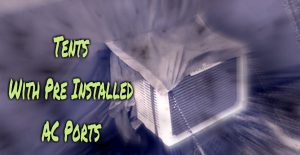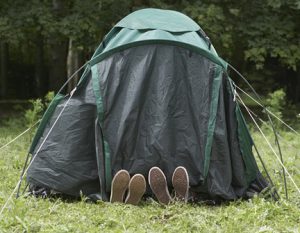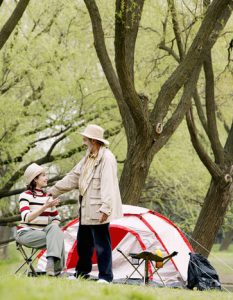 Summer, it’s the ideal season to go camping. Fresh air, cold beer, stunning wilderness, and fun times with the family. Camping in the summer can be a thrilling and memorable experience for many people, both children and adults. But the one downfall is that many camping tents become unbearably hot, so much so camping becomes too uncomfortable. So understanding how to keep a tent cool in summer should be one of your main camping preparation priorities.
Summer, it’s the ideal season to go camping. Fresh air, cold beer, stunning wilderness, and fun times with the family. Camping in the summer can be a thrilling and memorable experience for many people, both children and adults. But the one downfall is that many camping tents become unbearably hot, so much so camping becomes too uncomfortable. So understanding how to keep a tent cool in summer should be one of your main camping preparation priorities.
Intense heat can be a significant challenge to survive as it can quite literally turn your tent into an oven. If you are anything like me, this is no way to enjoy yourself. While I love the outdoors and summer, extreme heat is certainly not my friend.
Fortunately, there are many tips and tents for hot weather to deal with this problem. Some methods involve a drastic tent overhaul, modifications to an existing tent and simply being sun smart. Regardless of where you are in the world, it’s summertime somewhere. So these tips are relevant year round and if you’re dedicated enough (and have the cash flow) you may even be able to pull off a year round summer worldwide camping trip. So let’s take a look at some simple ways to keep a camping tent cool in the summertime.
Sometimes There’s No Beating The Summer Heat

Places like Arizona and Southern California reach day time temperatures of 110°F in the United States. While on the other side of the world places in Australia like Gladstone, Brisbane and Marble Bar in Western Australia have been known to reach temperatures over 40°C.
While at night time you expect temperatures to cool down, but in these areas and many more places around the world, the temperatures don’t always drop. Some nights are extremely humid and sticky while others are a grueling dry heat. So praying for a cold night during summer is not the best option to take when preparing for a summer camping trip. You must consider the option below if you want to remain cool all summer long. Surviving Scorching Hot Summer Days In A Tent
The Best Way To Stay Cool When Car Camping
So with temperatures soaring above 90°F, should you just cancel the trip and plan for a cooler week away?. That’s one option, but the other option is to keep your tent air conditioned. This may sound over the top, but you may be surprised by the amount of campers these days that take a portable air con unit with them. Especially in the hotter parts of the world.
This is ideal if you are car camping, or if you have your own generator to provide power. To successfully pull it off, you should really look for a tent with an air conditioning port pre-built into the tent. These tents have a dedicated opening for you to keep the air con unit in.
The air con unit remains outside the tent to keep condensation and excess water from running into the tent. The opening in which the air con unit sits has a pull down flap so you can cover the air con with the rain fly while also providing a insect screen so no bugs can get in through the port.
There’s no better way to stay cool on a hot summers night in a tent. If you’re car camping and have access to power, there’s no need to concern yourself with the energy bill. However you should respect your neighboring campers and buy a quite air con and have the unit located away from their tent.
The Type Of Tent To Buy For Summer Camping
The two main types of tents are made from nylon/polyester and canvas. Nylon being the thin lightweight more common tent, while the canvas being the heavy, thick and durable type of tent. There area advantages and disadvantages to both types of tents.
With nylon, the tent will be abused more by the sun, especially on scorching hot days. Some campers simply pack up there tents during the day to protect the materials from fading and breaking down as quickly.
Canvas material are often associated with winter camping tents. That is because they retain heat so much better then nylon tents. Canvas tents are generally classified as 4 season tents due to their ability to adapt to the climate. During winter they retain heat inside the tent far better than any other tent, while on hot days the canvas material breaths a lot better than nylon. But the downside is that canvas tents will remain warmer inside for longer in comparison to a nylon tent.
How Many Seasons Should A Summer Tent Be
Most tents will be 2 or 3 season tents, which is sufficient for summer camping. However, it’s important to note that these 3 season tents for summer will often have a mesh ceiling for greater air flow and a reduction in condensation inside the tent. Don’t be fooled into thinking you don’t need a rain fly over the top. Always buy the rain fly with the tent. This is not an option!.
A rain fly is intended to provide shelter from rain and storms. While it’s also a means of shade for you in the tent. So even when it’s not raining, the blaring hot sun directly on your skin is not ideal. The shade of a rain fly may end up saving your skin from serious sun burn and dehydration.
A Tent Designed For Hot Summer Days
In recent years new tents have emerged. These tents are known as ‘Dark Room Tents‘. These tents have been designed with 2 main objectives in mind. 1. Keep the tent much cooler during hot summer days and nights. 2. Provide a darker interior to the tent so you can sleep inside while the morning sun is rising without the sun blaring in your eyes.
These tents often have a black interior with built in skylights. The dark interior walls act as a shading element while the outside coating reflect the heat keeping the shade of the tent cooler. The skylight in the ceiling can be opened and closed as you see fit. To let extra light into the tent during the day, you open up the skylight. Or keep it open at night to star gaze without getting wet from potential rain.
If I wasn’t going to air condition my tent, a dark room tent would be my next best option.
How To Camp Sun Smart
Scout The Area For Shady Locations
Before setting up a tent, look for a place which has shade to protect you from the sun. This might be from tall cabins, ridges, low hills, or trees. Letting these things rather than your tent absorb the sunlight can be a smart idea to keep you cool.
Keep in mind that the position of the sun always moves, so it is better to keep the tent cool when you are inside. Such as early morning sun. A tent can heat up very quickly in the sun and unless you have a dark room tent, then the morning sun may unwittingly wake you up hours before you had planned.
You should also know where the sun will pass throughout the day as this will help you plan your daily activities to avoid full sun exposure all day long.
If the trees above your tent can provide massive shade at every angle from the sun, then you can leave it there all day and enjoy outdoor activities. Just keep an eye out for loose or broken branches that could fall on top of your tent.
Reflect The Sun For A Cooler Tent Interior
One of the most effective ways to stay cool inside your tent is to use reflective sunshades. These units can reflect direct sunlight to the sky and leave your tent in their shade much cooler. This allows you to have a comfortable sleep even when the sun comes up.
Reflective sunshades work best when you place them right on trees, poles, or stakes above the tent. Ideally, the gap between the sunshade and the tent is at least 10 inches, which allows cool air to move over the area and reduce the heat. Keep in mind that a sunshade does not need to be reflective or shiny, but it can also be a simple tarp.
Setup Your Tent Towards The Breeze
Winds are the Earths natural air conditioner. Even when there aren’t any signs of significant breeze, you can still take advantage to keep your tent always cool in the summer. A mesh tent allows air to flow through the area at day and night, thus making it easier for the breezes to cool off. Ideally, you should set up the tent door facing into the winds.
To find out the exact direction of the breezes, you can try three following ways:
- Check a weather app: most weather applications on your smartphone can show the direction of the breeze. For example, “4 mph SSE” means the wind is blowing at 4 miles per hour from the south-southeast.
- Use a finger: Hold your wet finger in the air. The cool side will show you the direction the breeze is coming from.
- Ask the local people: It is a good idea to ask local residents or the staff and owners of the campground as they might know wind direction and other weather conditions via forecast.
Mesh Tent Ceiling Is A Must For Beating The Heat
During the summer night, your body heat and hot air will gravitate upwards and can collect inside the rain fly. Making an insulation kind of affect. Which is not what we want, we want the opposite. So when you’ve checked the weather forecast and known there will be no rain, it’s better to remove the rain fly so that moisture and heat can escape. This could make a significant difference to keep your tent remain cool in the summer.
However, do you remember me stating that without a rainfly, the sun can burn you in the morning like a piece of bread in a toaster. So unless you set up a sun reflective system like a tarp, or have all round shade from a tree, leaving the rain fly on is the best bet. If you do take the rain fly off, make sure to keep it on hand to avoid any unexpected rainfall when you are sleeping.
Staying Cool In The Summertime Is Possible
When preparing for your camping trip in the summer, it is always better to choose a tent with as much mesh material as possible. This type can provide the ultimate protection against biting insects like mosquitoes, while still allowing air to circulate.
Some tents come with one or more air vents, usually located at the rear of the tent down low. Leave these vents open so cooler air from outside the tent can flush the warm air from inside the tent up and out of the mesh ceiling. Creating a lovely cross breeze.
When you see a tent with a bathtub floor, don’t be alarmed. This is a wet weather preventative feature to stop water from soaking in through the base and sides of the wall. Air can and will circulate throughout a mesh tent if it has bathtub flooring. I wouldn’t buy a tent without bathtub flooring, regardless of the season.
